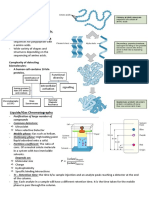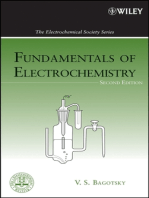0 ratings0% found this document useful (0 votes)
29 viewsReports: Chemiluminescence Resulting From Electrochemically Generated Species
Reports: Chemiluminescence Resulting From Electrochemically Generated Species
Uploaded by
saida1) Chemiluminescence was observed when aromatic hydrocarbons were electrolyzed in deoxygenated nonaqueous solvents.
2) Emission occurred near the cathode and was from the excited singlet state of the hydrocarbon.
3) Oxygen strongly quenched the chemiluminescence. Various experimental conditions, including alternating current, affected the intensity and location of observed light emission.
Copyright:
© All Rights Reserved
Available Formats
Download as PDF, TXT or read online from Scribd
Reports: Chemiluminescence Resulting From Electrochemically Generated Species
Reports: Chemiluminescence Resulting From Electrochemically Generated Species
Uploaded by
saida0 ratings0% found this document useful (0 votes)
29 views2 pages1) Chemiluminescence was observed when aromatic hydrocarbons were electrolyzed in deoxygenated nonaqueous solvents.
2) Emission occurred near the cathode and was from the excited singlet state of the hydrocarbon.
3) Oxygen strongly quenched the chemiluminescence. Various experimental conditions, including alternating current, affected the intensity and location of observed light emission.
Original Title
hercules1964
Copyright
© © All Rights Reserved
Available Formats
PDF, TXT or read online from Scribd
Share this document
Did you find this document useful?
Is this content inappropriate?
1) Chemiluminescence was observed when aromatic hydrocarbons were electrolyzed in deoxygenated nonaqueous solvents.
2) Emission occurred near the cathode and was from the excited singlet state of the hydrocarbon.
3) Oxygen strongly quenched the chemiluminescence. Various experimental conditions, including alternating current, affected the intensity and location of observed light emission.
Copyright:
© All Rights Reserved
Available Formats
Download as PDF, TXT or read online from Scribd
Download as pdf or txt
0 ratings0% found this document useful (0 votes)
29 views2 pagesReports: Chemiluminescence Resulting From Electrochemically Generated Species
Reports: Chemiluminescence Resulting From Electrochemically Generated Species
Uploaded by
saida1) Chemiluminescence was observed when aromatic hydrocarbons were electrolyzed in deoxygenated nonaqueous solvents.
2) Emission occurred near the cathode and was from the excited singlet state of the hydrocarbon.
3) Oxygen strongly quenched the chemiluminescence. Various experimental conditions, including alternating current, affected the intensity and location of observed light emission.
Copyright:
© All Rights Reserved
Available Formats
Download as PDF, TXT or read online from Scribd
Download as pdf or txt
You are on page 1of 2
ethylammonium bromide and tetra-
ethylammonium perchlorate (both po-
larographic grade); they were dried in
a vacuum oven for several hours at
60?C before being used.
The current-reversal technique with
Reports a single electrode was used. A current
of 3 to 10 ma was passed through the
cell for about 10 seconds and then
the direction of current flow was re-
versed. By this procedure the cathod-
ically produced species was generated
Chemiluminescence Resulting from Electrochemically in the vicinity of the anodically pro-
duced species and vice versa. Under
Generated Species these conditions emission occurred as
a glow covering the electrode and ex-
Abstract. Chemiluminescence is reported from chemical species produced dur- tending about 0.5 to 1.0 mm into
ing electrolysis of aromatic hydrocarbons in deoxygenated nonaqueous solvents. solution above the electrode surface.
Emission occurs in the solution near the cathode, and the emitting species is the There was a
delay of about 1 to 2
excited singlet state of the hydrocarbon. Oxygen exerts a severe quenching effect seconds between
switching the direc-
on the chemiluminescence. Possible mechanisms are discussed. tion of current flow and observing the
emission. The emission rose to a maxi-
Although a number of workers have working electrode with an external mum intensity in about 3 seconds and
studied a variety of chemiluminescent counter electrode separated from the then fell quickly. When the solution
systems, relatively little attention has solution by a fritted glass disc of fine was stirred, streaming of luminescence
been focused on light emission caused porosity; two platinum-foil electrodes from the electrode into solution (about
by electrolysis. In 1929 Harvey ob- separated from each other by about I I cm) was observed. Generally, emis-
served that chemiluminescence of lumi- cm; and two concentric cylindrical sion was more intense on switching
nol could be produced by electrolysis electrodes, the interior one a platinum the electrode from plus to minus than
in solution (1), and a few other in- rod (2.5 mm in diameter) and the on going from minus to plus.
vestigators followed up this work (2). exterior one constructed from 52-mesh When two square platinum elec-
Kuwana and co-workers using modern platinum gauze (6 mm in diameter). trodes were used and the solution was
electrochemical techniques have studied Studies were carried out (i) by pass- vigorously stirred, the emission ob-
the luminol system in detail (3). ing a current through the cell (without served continuously in the vicinity of
This report describes the production stirring the solution) for a given period the cathode, and was sufficiently
of chemiluminescence by the reaction of time and then quickly reversing the bright for some compounds (notably
of species produced during electrolysis direction of current flow; (ii) by ap- rubrene) that it was visible in dim
of aromatic hydrocarbons dissolved in plying a constant direct-current voltage, room light. The square-wave alternat-
deoxygenated nonaqueous solvents. The both with or without stirring; and (iii) by ing current produced a flashing effect
emission observed appears to be from applying an alternating-current square alternately at the two electrodes and
an excited singlet state of the hydro- wave, both with or without stirring. could excite luminescence up to a fre-
carbon and the light reaction occurs in The solvents used were dimethylforma- quency of 10 cy/sec for rubrene.
solution, not at the electrode surface. mide and acetonitrile, purified accord- When the concentric cylindrical elec-
Three different arrangements of elec- ing to described procedures (4, 5). trodes were used with 3 to 4 volts of
trodes were used: a single platinum The supporting electrolytes were tetra- direct current, a continuous emission
was observed even when the solution
was not stirred, diffusion being suffi-
Table 1. Aromatic hydrocarbons showing chemiluminescence produced by electrochemically cient to mix the reacting species.
generated species. The hydrocarbon concentrations were 10-3M. The supporting electrolyte
concentrations were 0.1 or 0.01M. Figure 1 shows a photograph of a
cell taken by light from the chemi-
Colors
Aromatic
Aromatic luminescent reaction. Table 1 lists some
hydrocarbon Solvent* Electrolytet I
SSolution of the hydrocarbons studied, the sol-
slChemiluminescence
fluorescence
vents and electrolytes used, and the
Anthracene CH3CN TEAB Blue-white (w) Blue-violet color of chemiluminescence compared
Chrysene CH,CN TEAB Blue-white (m) Blue-violet
Chrysene DMF TEAP Blue-white (m) Blue-violet with the color of solution fluo-
Pyrene DMF TEAB Blue-white (s) Blue rescence.
Naphthacene DMF TEAB Green (s) Green Some characteristics of the chemi-
Perylene DMF TEAP Blue (s) Blue
Perylene CH3CN TEAB Blue (s) Blue luminescent reaction have been de-
Perylene DMF TEAB Blue (s) Blue duced from simple experiments. The
Coronene DMF TEAB Blue (m) Blue
Rubrene DMF TEAB Orange-red (vs) Orange-red hydrocarbon is essential for chemi-
Decacyclene DMF TEAB Green (w) Green luminescence because no emission was
1,2,5,6-Dibenz- DMF TEAB Blue-violet (m) Violet observed at the same current densities
anthracene
when only supporting electrolyte and
DMF, dimethylformamide. t TEAB, Tetraethylammoniumbromide. TEAP, tetraethylammonium solvent were used. The correlation be-
perchlorate. $ w, weak emission; m, moderate intensity; s, strong emission; and vs, very strong
emission. tween the color of chemiluminescence
808 SCIENCE, VOL. 145
off quickly, but was resumed at a re- plexed aromatic positive radical ion
duced intensity upon connecting the (such as Ar2W)at the anode which is
circuit again. This process could be re- stable enough to be transported to
peated several times, the emission be- the cathode. Although no such species
coming less intense each time, until has been reported, Ar+ is a good
finally no emission was observed upon electron acceptor and aromatic hydro-
connecting the circuit. Oxygen showed carbons are good electron donors, form-
a pronounced quenching effect on the ing molecular complexes readily. This
emission, indicating the participation of idea receives some support from the
free radicals, since all of the hydro- fact that molecular complex formation
carbons studied are fluorescent in air- has been reported with the tropylium
saturated solutions at room tempera- ion (7) and the pyrylium ion (8) as
ture. Water had no effect on the emis- acceptors, and that the concentration
sion, a result that was surprising but of hydrocarbon in these studies (10-3M)
consistent with observations on the is in the range where complex forma-
electrochemical behavior of the bi- tion is known to occur.
phenyl negative radical ion (4). DAVID M. HERCULES
One is tempted to interpret the Department of Chemistry and
chemiluminescence as arising from the Laboratory for Nuclear Science,
reaction of hydrocarbon radical ions Massachusetts Institute of Technology,
Fig. 1. Electrochemically generated lumi- (Ar+ and Ar-) to produce an excited Cambridge
nescence; emission from the electrode is singlet state (Ar*):
References and Notes
the only source of light (60 seconds; f,
4.5; Royal-X-pan film). The solution was Ar+ + Ar- Ar* + Ar (1) 1. N. Harvey, J. Phys. Chem. 33, 1456 (1929).
2. V. Vojiir, Collectioln Czech. Chem. Coilimmun.
10-3M rubrene in dimethylformamide which then emits its characteristic 19, 862 (1954); A. Bernanose, T. Bremer, P.
with 0.01M tetraethylammonium bromide Goldfinger, Bull. soc. chim. Belges 56, 269
as supporting electrolyte. Concentric elec- fluorescence. However, this interpre- (1947).
trodes with nitrogen continuously bubbling tation is not consistent with all the 3. T. Kuwana, J. Electroanal. Chem. 6, 164
(1963); , B. Epstein, E. T. Seo, J.
through the solution. The clear definition data presented. Because emission in Phys. Chem. 67, 2243 (1963).
of the electrode grids when viewed head- stirred solutions occurs mainly in the 4. D. Maricle, Anal. Chem. 35, 683 (1963).
on, and the diffuse glow lat the sides indi- 5. J. F. Coetzee, G. P. Cunningham, D. K. Mc-
vicinity of the cathode and because the Guire, G. R. Padmanabhan, Anal. Chenm. 34,
cate that the glow occurs in solution near 1139 (1962).
the inside electrode surface. positive aromatic hydrocarbon ions are 6. J. P. Paris, W. Prichard, D. M. Hercules,
less stable under the conditions of the unpublished studies, Juniata College, 1962.
7. M. Feldman and S. Winstein, J. Am. Chenm.
experiments than the negative radical Soc. 83, 3338 (1961).
and normal fluorescence indicates that ions (6), it seems unlikely that Ar* 8. , Tetrahedron Letters, 1962, 853 (1962).
9. Supported in part by the U.S. Atomic Energy
the lowest excited singlet state of the would be transported from the anode Commission under contract AT(30-1)-905 and
aromatic hydrocarbon is the emitting to the cathode while the more stable by USPHS grant GM 1.1.766-01 from the Na-
tional Institutes of Health. I thank J. P. Paris
species. Because chemiluminescence Ar- is not transported from the cath- for his contribution to this work.
was observed with both perchlorate ode to the anode. 1 July 1964
and bromide as supporting electro- The species produced at the cathode
lytes, anodically produced bromine seems to be Ar- as judged by colors
does not participate in the light-pro- observed with the naked eye at the
ducing reaction. Also, allowing a dilute cathode when electrolyses were per- Late Eocene Multituberculates
bromine solution to flow over the formed in room light. This would sug- and Other Mammals from Wyoming
cathode during electrolysis produced no gest the possibility of oxidation of Ar-
emission. Because of the delayed re- by an anodically generated species to Abstract. Isolated teeth of multi-
sponse encountered in the current- produce chemiluminescence. Energy tuberculates have been found in associ-
reversal experiments and the observa- considerations argue against such a ation with late Eocene fossil mammals.
tion of streams of luminescence in mechanism because, to produce an Previous studies reported that multi-
stirred solutions, chemiluminescence is excited singlet state of the hydrocarbon tuberculates were not found in deposits
not produced by a reaction at the elec- by oxidation of Ar-, one must remove younger than early Eocene age (Gray-
trode surface. In stirred solutions, an electron from a ir-bonding orbital bull provincial substage or equivalents).
emission was observed only in the vi- while leaving an electron in a higher- This newly found occurrence indicates
cinity of the cathode, and this indi- energy 7r-antibonding orbital. This also that these animals are more likely to
cates that the more stable of the two leaves the nature of the species pro- be late Eocene in age than reworked
species is generated at the anode. This duced at the anode in question, be- early Eocene materials.
observation may be correlated with the cause the experiments described indi-
emission observed at the electrode cate that luminescence cannot be pro- Joint field parties of Carnegie Mu-
when the current was reversed from duced by oxidation of Ar- by molecu- seum and the University of Colorado
plus to minus-although sometimes a lar bromine. The possibility of having Museum have been collecting fossil
weaker emission could be seen at the a complexed bromine radical (such as vertebrates from upper Eocene deposits
other electrode, particularly in the case Br2-) react with Ar- is unlikely because (Tepee Trail formation, Hendry Ranch
of chrysene. Also, in the current-re- chemiluminescence is observed in per- member) of the Badwater area, Na-
versal experiments, if the circuit was chlorate media. trona County, Wyoming (1, 2). In the
broken while chemiluminescence was One possible way out of the dilemma course of collecting small fossils by
being emitted, the emission dropped is to postulate production of a com- washing techniques, remains of a multi-
21 AUGUST 1964 809
You might also like
- 967.27 Salmonella en Alimentos - IdentificaciónDocument3 pages967.27 Salmonella en Alimentos - IdentificaciónJavier muñozNo ratings yet
- Spectrophotometric Analysis of A Two Component MixtureDocument3 pagesSpectrophotometric Analysis of A Two Component MixtureDozdi100% (11)
- CBLM Core Smaw nc1Document57 pagesCBLM Core Smaw nc1MANPOWER ORMOC100% (5)
- Electrogravimetry: Electrogravimetric Analysis V Semester Inorganic ChemistryDocument2 pagesElectrogravimetry: Electrogravimetric Analysis V Semester Inorganic Chemistryvandv printsNo ratings yet
- Electrochemical Oxidation of 1,2-Dimethoxybenzene: Synthetic AspectsDocument4 pagesElectrochemical Oxidation of 1,2-Dimethoxybenzene: Synthetic AspectsHaresh BhaliyaNo ratings yet
- BY P.Sravanthi M.pharmacy 1styear-Pharmaceutical Analysis TRINITY College of Pharmaceutical SciencesDocument32 pagesBY P.Sravanthi M.pharmacy 1styear-Pharmaceutical Analysis TRINITY College of Pharmaceutical SciencesanithaNo ratings yet
- Experiment 1 FINALDocument12 pagesExperiment 1 FINALMaiSakurajimaNo ratings yet
- Cơ chế của TrietanolamineDocument5 pagesCơ chế của TrietanolamineQuanHoangNo ratings yet
- Cap. 13Document47 pagesCap. 13Jeanynne LeiteNo ratings yet
- UNIT II - Photochemistry 1Document102 pagesUNIT II - Photochemistry 1ashNo ratings yet
- Phân tích điện hóa 2023Document135 pagesPhân tích điện hóa 2023Hoàng Oanh Nguyễn MaiNo ratings yet
- UV-Visible Spectroscopy PPT B.TechDocument46 pagesUV-Visible Spectroscopy PPT B.TechGunnika SharmaNo ratings yet
- Summary of EXP3Document9 pagesSummary of EXP3Tany TurkiNo ratings yet
- Fleischmann1987-Comportement Des MicroélectrodesDocument9 pagesFleischmann1987-Comportement Des MicroélectrodessyliusNo ratings yet
- An Introduction To Infrared Spectrometry: Mid-, and Far-Infrared RadiationDocument39 pagesAn Introduction To Infrared Spectrometry: Mid-, and Far-Infrared RadiationRosi GustiaNo ratings yet
- Module 1 Notes 1chem Mescenotes - inDocument63 pagesModule 1 Notes 1chem Mescenotes - inHafizNo ratings yet
- Ir SpectrosDocument32 pagesIr SpectrosAnonymous vr1l9YlnsNo ratings yet
- Atomic SpectrosDocument67 pagesAtomic SpectrosRadius Julius100% (2)
- Clinical Chemistry ResearchDocument14 pagesClinical Chemistry ResearchNico Loko100% (1)
- Atomic and Molecular Spectroscopy-2 PDFDocument60 pagesAtomic and Molecular Spectroscopy-2 PDFHaseeb HaiderNo ratings yet
- Applications of Spectroscopy NotesDocument7 pagesApplications of Spectroscopy Notesaryantechs1365No ratings yet
- Concentration Dependence of CuSO4 Electrolysis (With Model Fitting) (Tony 2016)Document11 pagesConcentration Dependence of CuSO4 Electrolysis (With Model Fitting) (Tony 2016)Om RanjalkarNo ratings yet
- ChemiluminescenceDocument18 pagesChemiluminescenceza chohan100% (1)
- Principles of SpectrosDocument20 pagesPrinciples of SpectroschebetjudynNo ratings yet
- Conductometry Theoretical Part: Application Bulletin 102/3 eDocument6 pagesConductometry Theoretical Part: Application Bulletin 102/3 eYacine MadjidNo ratings yet
- Application of Electrochemical Detection in High-Performance Liquid Chromatography The Assay of Biologically Active CompoundsDocument7 pagesApplication of Electrochemical Detection in High-Performance Liquid Chromatography The Assay of Biologically Active CompoundssorinamotocNo ratings yet
- ElectrolysisDocument8 pagesElectrolysisbharadwaj.sanchit77No ratings yet
- Electrochemistry - 1Document17 pagesElectrochemistry - 1Farina FaraziNo ratings yet
- PKU 2020 - Nur Lailatul Fitriyah Abidin - 24 - Lapres ElektrogravimetriDocument26 pagesPKU 2020 - Nur Lailatul Fitriyah Abidin - 24 - Lapres ElektrogravimetriFitriyah AbidinNo ratings yet
- Experiment Cyclic Voltammetry Teacher Edition 4Document12 pagesExperiment Cyclic Voltammetry Teacher Edition 4Shaiju S SNo ratings yet
- E FTIRppt16.TmpDocument61 pagesE FTIRppt16.Tmpebrahim.alosteNo ratings yet
- Module 3 Molecular Spectroscopy and Thermal AnalysisDocument31 pagesModule 3 Molecular Spectroscopy and Thermal Analysisjobin2022jiNo ratings yet
- Dominikus - Jurnal Reaksi Perisiklik 2Document3 pagesDominikus - Jurnal Reaksi Perisiklik 2Ekin Dwi ArifNo ratings yet
- 16527Document22 pages16527Jaikrishna SukumarNo ratings yet
- TEST-12Document16 pagesTEST-12yatharth350No ratings yet
- Seminar II Recent Advances in Electrochemiluminescence By: Yegezu M. July, 2022 Addis AbabaDocument35 pagesSeminar II Recent Advances in Electrochemiluminescence By: Yegezu M. July, 2022 Addis AbabaYegezu MebratuNo ratings yet
- Spectroscopy NotesDocument19 pagesSpectroscopy NotesNeeraj100% (4)
- Elson 1976Document5 pagesElson 1976jiena.paucoNo ratings yet
- Transference NumberDocument4 pagesTransference Numberarun rajaramNo ratings yet
- This Study Resource WasDocument9 pagesThis Study Resource WasNurul izzatiNo ratings yet
- An Electromagnetic WaveDocument54 pagesAn Electromagnetic WaveKomal DahiyaNo ratings yet
- Wightman SecretionDocument49 pagesWightman Secretioncuentacompartida.comodinNo ratings yet
- Determination of Activity and Activity Coefficient From Cell Emf 2Document7 pagesDetermination of Activity and Activity Coefficient From Cell Emf 2Khrystin Jean Berdos100% (2)
- Electronic Spectra 233Document26 pagesElectronic Spectra 23324timeuserjrNo ratings yet
- Lecture 20-03-12Document36 pagesLecture 20-03-12toxiczarrar.pubgNo ratings yet
- CH-103-4th LectureDocument14 pagesCH-103-4th LectureDhruv DhirawaniNo ratings yet
- VC - Introducing Dynamic Electrochemistry Into The Physical Chemistry CurriculumDocument4 pagesVC - Introducing Dynamic Electrochemistry Into The Physical Chemistry CurriculumGabriel Omar Lozano SanchezNo ratings yet
- Visible and Ultraviolet Spectroscopy-Part 2Document54 pagesVisible and Ultraviolet Spectroscopy-Part 2Amusa TikunganNo ratings yet
- Engg Chemistry PDFDocument201 pagesEngg Chemistry PDFShamawn Muktadeer ShovonNo ratings yet
- JP 1040234Document8 pagesJP 1040234Chem CU706No ratings yet
- Tro 3rded Chapter2 CH FA14Document13 pagesTro 3rded Chapter2 CH FA14tamaraNo ratings yet
- 9 Molecular PropertiesDocument11 pages9 Molecular PropertiesNishantvermaNo ratings yet
- Electrogravimetry 1Document21 pagesElectrogravimetry 1yassershshNo ratings yet
- Radiochemical MethodsDocument29 pagesRadiochemical MethodsKHNo ratings yet
- Beer's LawDocument8 pagesBeer's Lawjuser2007No ratings yet
- Highly Luminescing Rhenium (1) Heterocyclic Ligand Tetracarbonyl ComplexesDocument2 pagesHighly Luminescing Rhenium (1) Heterocyclic Ligand Tetracarbonyl ComplexesPablo MellaNo ratings yet
- CC Lec QuizzesDocument8 pagesCC Lec QuizzesIra TamayoNo ratings yet
- Chem - M2 Ktunotes - inDocument36 pagesChem - M2 Ktunotes - inArsha AnishNo ratings yet
- CHM 403 Electrochemistry NoteDocument21 pagesCHM 403 Electrochemistry Notepeterononuju49No ratings yet
- UV Vis DNUDocument41 pagesUV Vis DNUNasima akterNo ratings yet
- Photochem 2 PDFDocument8 pagesPhotochem 2 PDFSarahPèleNo ratings yet
- Selection of Culture Medium and Incubation Time For Growth and Production of Beauvericin by LocalDocument7 pagesSelection of Culture Medium and Incubation Time For Growth and Production of Beauvericin by LocalsaidaNo ratings yet
- mn_1000_b_210Document22 pagesmn_1000_b_210saidaNo ratings yet
- ajidm-9-4-1Document8 pagesajidm-9-4-1saidaNo ratings yet
- J Biocontrol 2021 104586Document13 pagesJ Biocontrol 2021 104586saidaNo ratings yet
- Media and Fermentation Processes For The Rapid ProDocument11 pagesMedia and Fermentation Processes For The Rapid ProsaidaNo ratings yet
- Auto Hematology AnalyzerDocument1 pageAuto Hematology AnalyzersaidaNo ratings yet
- Electrochemiluminescence (ECL) : Mark M. RichterDocument34 pagesElectrochemiluminescence (ECL) : Mark M. RichtersaidaNo ratings yet
- EUA Roche Elecsys IfuDocument25 pagesEUA Roche Elecsys IfusaidaNo ratings yet
- Perlite Filter AidDocument3 pagesPerlite Filter AidSerdar OzkulaNo ratings yet
- Palampur: Questions/Answers Related To This Video and ChapterDocument4 pagesPalampur: Questions/Answers Related To This Video and ChapterRajesh DubeyNo ratings yet
- Underwing Nozzles: Carter Ground FuelingDocument19 pagesUnderwing Nozzles: Carter Ground FuelingHenryNo ratings yet
- FormingPotential EN PDFDocument28 pagesFormingPotential EN PDFNhan LeNo ratings yet
- CJT CONN BroschureDocument756 pagesCJT CONN BroschureOzanNo ratings yet
- Sacrificial Anode Cathodic ProtectionDocument8 pagesSacrificial Anode Cathodic Protectionnero daunaxilNo ratings yet
- Class 6 Ch-5 Changes Around UsDocument6 pagesClass 6 Ch-5 Changes Around UsrambabusrkNo ratings yet
- Qin 2023Document12 pagesQin 2023Cesar MorenoNo ratings yet
- Spice Notes in PerfumeryDocument6 pagesSpice Notes in PerfumeryTheo Martinez100% (2)
- Wirphool Adp 332 S WH Program MaualDocument4 pagesWirphool Adp 332 S WH Program MaualIvanNo ratings yet
- Hazardous Waste Storage and LabelingDocument7 pagesHazardous Waste Storage and Labelingavie100% (1)
- Busbar TightnessDocument11 pagesBusbar Tightnesssanjeev267No ratings yet
- Alpha Domain StructureDocument35 pagesAlpha Domain StructureRekha Govindan100% (1)
- Tips and Tricks HPLC Troubleshooting AgilentDocument30 pagesTips and Tricks HPLC Troubleshooting AgilentverajaNo ratings yet
- Chemistry Paper 1Document14 pagesChemistry Paper 1Charles OmondiNo ratings yet
- Structural Elucidation of Small Organic Molecules by 1d 2d and Multi Dimensional Solution NMR Spectroscopy 2155 9872.S11 001Document8 pagesStructural Elucidation of Small Organic Molecules by 1d 2d and Multi Dimensional Solution NMR Spectroscopy 2155 9872.S11 001PriyosetyokoNo ratings yet
- Gel Electrophoresis PresentationDocument17 pagesGel Electrophoresis PresentationLester HebertNo ratings yet
- Antiespumantes AshlandDocument28 pagesAntiespumantes AshlandEmilio TafurNo ratings yet
- Chemguide - Answers: Naming Organic Compounds: 1Document6 pagesChemguide - Answers: Naming Organic Compounds: 1Anant Catalyst ShuklaNo ratings yet
- Electrical Metallic Tubing (EMT)Document36 pagesElectrical Metallic Tubing (EMT)Jama CasayNo ratings yet
- Cryogenic Grinding: An Independent Voice: CryogenicsDocument3 pagesCryogenic Grinding: An Independent Voice: CryogenicsJainy ShahNo ratings yet
- BASF E-CPI 1016e ButyltriglycolDocument3 pagesBASF E-CPI 1016e ButyltriglycolsimphiweNo ratings yet
- Glycol PlantDocument8 pagesGlycol PlantDian Risti PurwantiNo ratings yet
- Non-Renewable Fuels Environmental Impact: EGEE 102 - Energy Conservation and Environmental ProtectionDocument40 pagesNon-Renewable Fuels Environmental Impact: EGEE 102 - Energy Conservation and Environmental ProtectionIan Jimbo ConstantinoNo ratings yet
- Analysis of Group Iv CationsDocument5 pagesAnalysis of Group Iv CationsjudeNo ratings yet
- Pattern Types and AllowancesDocument10 pagesPattern Types and AllowancesANIKET ANANDNo ratings yet
- OMD552 Hospital Waste Management UNIT-3Document22 pagesOMD552 Hospital Waste Management UNIT-3Saravanakumar MNo ratings yet
- Usnrc 1.78Document17 pagesUsnrc 1.78mohanNo ratings yet

































































































